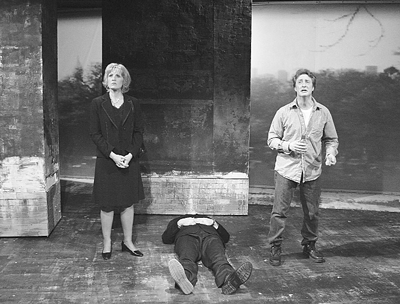Joyce classic reanimated with techno-wizardry
James Joyce’s “Ulysses,” the chronicle of a hapless schlub’s Homeric one-day odyssey through Dublin, is widely regarded as the finest English-language novel of the 20th Century. It’s also notorious for being fraught with dense, stream-of-conscious prose, rendering the work virtually unreadable.
With “Dead City,” playwright Sheila Callaghan (“The Hunger Waltz”) and the New Georges Theater Company aim to fix that. Claiming to have actually read the magnum opus—unlike artistic director Susan Bernfield, who admits in the program notes she has yet to finish it—Callaghan has crafted her own feminist take on the tale. The literary classic has been updated for the stage, compressed to a mere 100 minutes without intermission, and energized with eye-popping high-tech flourishes.
Subbing Manhattan for Dublin, and Samantha Blossom for protagonist Leopold Bloom, Callaghan insists that the play is a “personal reaction” rather than a true adaptation. Indeed, “Dead City” valiantly succeeds in capturing the random swirl of Joyce’s onerous urban landscape, illustrating how a single day of navigating its perils can be an adventure that reinvigorates the soul.
But what about all that plot and blather? A staggering amount, sad to say, has been retained.
Samantha (Elizabeth Norment), a 42-year old Internet consultant, awakens one morning in her sprawling Upper East Side apartment more dazed than usual. She has grown detached from her philandering Jazz-singer husband, Gabriel (the scrumptious Peter Rini), who seems more concerned about skin care products than his wife. Haunted by the memory of a son, Zachary, stillborn 22 years earlier, Samantha laments failing to bond with her “Barbie-doll” daughter who’s away at Vassar.
Like Joyce’s Bloom, Samantha’s very busy day (specifically June 16, celebrated by Joyce-aholics worldwide as “Bloomsday”) is served up in hourly increments. Helpful scene headings noting time and place—many of them New York landmarks—are projected on the ever-shifting mottled gray walls that dominate the spare set by Cameron Anderson.
Samantha’s workaday gyrations are imbued with extraordinarily cryptic overtones. The NPR radio announcer, after the weather report, warns her to go easy on the “I Can’t Believe Its Not Butter” for Gabriel’s gluten-free toast. She visits a spa where mind-reading massage therapists recite her random musings about Gabriel’s mistress and her own illicit trysts. At a burial in Queens, the corpse rises and speaks. While researching tattoos at the New York Public Library, she overhears a sexual encounter. Later, in Battery Park, she hooks up with a poseur goon she met on the Internet.
Round and round Samantha goes, ‘til late when she lands in an outré dance club in the Meatpacking District and has an epiphany.
Amplifying the day’s mystery, Samantha repeatedly encounters Jewel (April Matthis), a gifted lesbian poet who, being the same age Zachary would have been, invades Samantha’s psyche. This moody, self-destructive soul (the Stephen Dedalus character in “Ulysses”) worships ‘70s punk goddess, Patti Smith, and is similarly wracked by a familial death.
Director Daniella Topol does an admirable job of staging this morass of material, as daunting as any task faced by the Greek hero, Ulysses, himself.
The exceptional Elizabeth Norment, reminiscent of Judith Light from “Who’s the Boss” minus the shoulder pads, exudes a stoic, determined air that belies her consuming pain.
Among the supporting cast, Rebecca Hart stands out as the maniacal Nora, head of a cutting edge sales company barking orders to her minions. She delivers her overblown lines, such as, “Emancipate the gravitas!” with deranged glee, and we actually get her meaning.
Without the fizz of the awesome multi-media effects, courtesy of the spanking new state-of-the-art 3LD Art & Technology Center, surely “Dead City” would fall flat. Video images projected on a vast background screen appear eerily real. When a cab whooshes by you can almost feel the rushing wind. When the club music gets cranking, the base thumps beneath your feet. Projection whiz William Cusick and sound director Robert Kaplowitz employ a small army of technicians to produce such sensations.
To be sure, “Dead City” breathes welcome new life into a musty 100-year old classic. Yet this labored production is crammed with so much action it all registers as a dull blur, as irksomely obtuse as its source.
Early on, a friend of Samantha remarks, “Death. It’s an opiate. Numbs you to the world” and later says, “Ah, the Internet. It’s an opiate.”
Despite best efforts to prove otherwise, “Dead City” ultimately becomes an opiate as well, albeit a fascinatingly potent one that’s worth ingesting.
gaycitynews.com

































